Nellore district
| Sri Potti Sriramulu Nellore district | |
|---|---|
| District of Andhra Pradesh | |
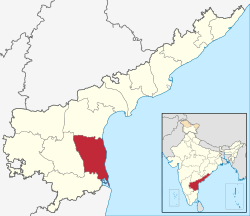 Location of Sri Potti Sriramulu Nellore district in Andhra Pradesh | |
| Country | India |
| State | Andhra Pradesh |
| Administrative division | Sri Potti Sriramulu Nellore district |
| Headquarters | Nellore |
| Tehsils | 46[1] |
| Government | |
| • District collector | Revu Mutyalaraju IAS |
| • Lok Sabha constituencies | Nellore (Lok Sabha constituency) |
| • Assembly seats | 10 |
| Area | |
| • Total | 13,076 km2 (5,049 sq mi) |
| Population (2011) | |
| • Total | 2,966,082[2] |
| • Urban | 29.07% |
| Demographics | |
| • Literacy | 69.15% |
| • Sex ratio | 986 |
| Vehicle registration | AP-26 |
| Major highways | NH 5,NH 67 |
| Coordinates | 14°26′N 80°0′E / 14.433°N 80.000°ECoordinates: 14°26′N 80°0′E / 14.433°N 80.000°E |
| Website | Official website |
Nellore district (officially: Sri Potti Sriramulu Nellore district), located in Coastal Andhra region is one of the 13 districts of Andhra Pradesh. The population of the district according to the Census 2011 was 2,966,082 of which 29.07% were urban. Nellore city is its administrative headquarters. The district is bordered by the Bay of Bengal to the east, Kadapa district to the west, Prakasam District to the north, Chittoor district and Thiruvallur district of Tamil Nadu to the south.[2]
Etymology
The name of the district derives from the name of the district headquarters, Nellore. The district was known as Vikrama Simhapuri until the 13th century and later it came to be referred to as Nellore. A mythological story from Sthala Purana depicts, a lingam in the form of a stone under nelli tree. The place gradually became Nelli-ooru (Nelli=Name of the Tree and ooru=place) and then to present day Nellore.[3] Government of Andhra Pradesh officially renamed the district as Sri Potti Sri Ramulu Nellore District after the freedom fighter and revolutionary Potti Sri Ramulu, who died fasting in an attempt to achieve the formation of a separate state for the Telugu people.[4]
History
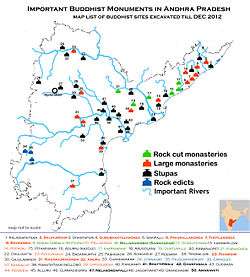
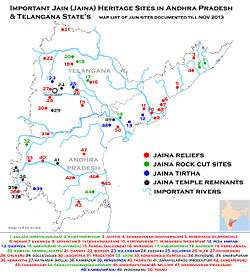
Mauryas, early Cholas and Pallavas
With the rise of the Mauryan Empire, many parts of the Andhra Pradesh including Nellore came under its influence and was part of the Ashoka empire in the third century B.C. The Cholas were an important dynasty in the south peninsula. The early Cholas ruled between the 1st and the 4th centuries A.D. The earliest chola inscription from 1096 A.D. was found at Jummaluru. The district was part of the first and the most famous Chola, Karikalan. He was well known for his great engineering marvel.
Chola power declined with frequent attacks by the Pallavas, Cheras and Pandyas, until they rose to power again around the 9th century. Chola rule was broken when the Cholas were overthrown by Simha Vishnu Pallava and the region came under the Pallava rule between the fourth and sixth centuries A.D. With the dawn of the seventh century, the political centre of Gravity of the Pallavas shifted to the south and weakened their power towards the north. Several ancient Pallava and Chola temples are in Udayagiri village. Several inscriptions about Pallava rule were found in the Guntur-Nellore tract of the Andhra Pradesh. The big four storeyed cave at Vundavalli and 8 cave temple at Bhairavkonda resembles the Pallava architecture during Mahendravarma's period.
Nellore Chola kings
This was the period when the political power of Nellore was at its peak and also reached its ebb. Tikkana Somayajulu, a minister and famous Telugu poet who translated Mahabharatham into Telugu, gave the account of the history of this family in his other book called Nirvachanottara Ramayanamu. A branch of Telugu Cholas, feudatory of the Western Chalukyas of Kalyani appointed them as rulers of Pakanadu for helping in the war between Cholas and Chalukyas. They ruled over the region consisting of the Nellore, Kadapa, Chittur and Chengalput districts with Vikramasimhapuri (modern Nellore) as their head capital.
Tikka (1223–1248) defeated both the Hoyasala and the Pandyas and got the Tondaimandalam region and assumed the title Cholasthapanacharya. During the reign of Tikka's son and successor Manumasiddhi II (1248–1263), Nellore faced lot of attacks from other Chalukyas and Pandyas. Tikkana visited Ganapatideva of Kakatiyas and gained military support for his king. About the year 1260, a dangerous feud broke out between Manumasiddhi and Katamaraju, the chief of Erragaddapadu in Kanigiri region. The feud was on the issue of the rights of the two princes to use certain wide meadows as grazing grounds for their flocks of cattle. It led to the bloody battle fought at Panchalingala near Muttukuru on the coast of river Penna. Manumasiddhi's forces led by Khadga Tikkana, the cousin of poet Tikkana won the battle, but the leader perished. This feud and the consequent battle formed the theme of the popular ballad entitled "Katamaraju Katha". Shortly after or during this battle, Manumasiddhi died and Nellore lost its significance.
Kakatiyas, Pandyas and Vijayanagara rulers
The Kakatiyas, the feudatories of the Western Chalukyas of Kalyani, under influence of Prola declared his independence. Ganapati Deva, the first great king of Kakatiyas brought most of the Telugu area under his rule. Nellore was part of kakatiya kingdom in the 13th century. It changed hands between them and Pandyas few times until Prataprudra II defeated Pandyas. After the fall of Kakatiya Empire, the region was under Tuglaq and then was later under Kondavidi Reddis.
The most parts of the district were annexed by the Sangama dynasty of the Vijayanagara empire in the 14th century. The remaining portions of the district like Udayagiri were conquered in 1512 by Krishnadeva Rayalu, the greatest king of the kingdom. The ruins of fortress built by the Vijayanagar kings in the 14th century are at Udayagiri.
The Nawabs and the British period
After the fall of the Vijayanagara Empire, the area was ruled by the Nawabs. It was under rule of Najeebullah, the brother of Arcot Nawab in 1753. The district witnessed wars between Najeebullah and Nawab with support from French at Machilipatnam and British at Madras. Army under colonel Cailluad took over Nellore fort in 1762 and handed it over to Nawab. On the assignment of revenues, Nawab Ajim Ud Duaula gave Nellore town back in 1781 and gave the rest of the district to East India company in 1801. East India Company had taken control appointed Mr. Dyton as the 1st Collector. Nellore was declared the revenue unit for the district.[5]
During the British period, the district was at peace, the only event of any political importance being the sequestration in 1838, of the Jagir of Udayagiri, owing to its title holder's participation in a conspiracy, engineered by the Nawab of Kurnool, against the ruling power. After the district came under the British administration, the jurisdiction of the district did not undergo any major changes, but for the transfer of Ongole taluk in 1904 to Guntur district when it was newly constituted.
Post Indian Independence
It was part of the composite Madras state until 1 October 1953. On 1 November 1956, when the states were reorganised on a linguistic basis, the district came under Andhra Pradesh. Nellore played a major role in the formation of Andhra Pradesh state. Potti Sriramulu, a Telugu patriot and activist, fasted to death for the formation of Andhra Pradhesh state.
Nellore people participated in Indian Independence movement. Notable freedom fighters are Muttharaju Gopalarao and Potti Sriramulu. Nellore has produced two former chief ministers of state, Dr Bezawada Gopala Reddy and Nedurumalli Janardhana Reddy. The main political parties of the district are YSR Congress and Telugu Desam party. Communist parties of India also have more followers compared to the neighbouring districts like Kadapa and Ongole. Puchalapalli Sundaraiah, a founding member of the Communist Party of India (Marxist), attempted to establish communism here.
In 1970, part of Nellore district was split off to become part of Prakasam district.[6]
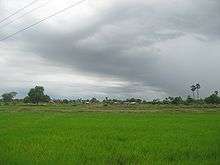
Epigraphical Records
There are many Telugu inscriptions in Nellore district of several kingdoms.[7][8]
Geography
The district lies between 13 30’ and 15 6’ of Northern latitude and 70 5’ and 80 15’ of Eastern latitude. Nellore's total land area is 13,076 square kilometres (8,761) sq. miles. It is bordered by the Bay of Bengal to the east, the state of Rayalaseema to the South, the district of Cuddapah, and the district of Prakasam to the north. The eastern side consists of area of low-lying land extending from the base of the Eastern Ghats to the sea. The west side of the district is separated from Cuddapah district by Veligonda hills. The district is split by the River Pennar and is located on both south and north banks of it.
Nellore district occupies an area of 13,076 square kilometres (5,049 sq mi),[9] comparatively equivalent to the Philippines' Negros Island.[10] It has an average elevation of 19 metres (62 feet).
About the half of the total area is cultivated and the rest is wasteland[11] because of it is rocky land, sandy coastline or covered with scrub jungles. Pennar, Swarnamukhi and Gundlakamma are the main rivers that flow through the most of the district. They are not navigable, and are mainly used for irrigation purposes. Tributaries to Penna like Kandaleru and Boggeru serve the remaining area. This area is rich in particular kind of flint called quartzite, out of which the prehistoric man made his weapons and implements.
Climate
The maximum temperature is 36-46c during summer and the minimum temperature is 23-25c during winter. The rainfall ranges from 700–1000 mm through South West and North East Monsoons. Nellore is subjected to both droughts and floods based on the seasons.
Demographics
According to the 2011 census, Nellore district has a population of 2,966,082,[12] roughly equal to the nation of Armenia[13] or the US state of Mississippi.[14] This gives it a ranking of 126th in India (out of a total of 640).[12] The district has a population density of 227 inhabitants per square kilometre (590/sq mi).[12] Its population growth rate over the decade 2001–2011 was 11.15%.[12] Sri Potti Sriramulu Nellore has a sex ratio of 986 females for every 1000 males,[12] and a literacy rate of 69.15%.[12]
The population of the district was 29,66,082 of which 22.45% were urban as of 2011.[15] Telugu is official and widely spoken language.
Economy
The Gross District Domestic Product (GDDP) of the district is ₹30,482 crore (US$4.2 billion) and it contributes 5.8% to the Gross State Domestic Product (GSDP). For the FY 2013-14, the per capita income at current prices was ₹80,782 (US$1,100). The primary, secondary and tertiary sectors of the district contribute ₹9,729 crore (US$1.4 billion), ₹6,320 crore (US$880 million) and ₹14,433 crore (US$2.0 billion) respectively.[16] The major products contributing to the GVA of the district from agriculture and allied services are, paddy, sugarcane, lemon, tomato, milk, meat and fisheries. The GVA to the industrial and service sector is contributed from construction, electricity, manufacturing, transport and education.[16]
Mining
Nellore district is known for producing largest quantity of crude Mica in India[17]. In 2011-12, 1784 tonnes of (crude) Mica were produced from Nellore district, thereby contributing a significant portion to the overall production of (crude) Mica in India, which totals to 1899 tonnes.[18]
Administrative divisions
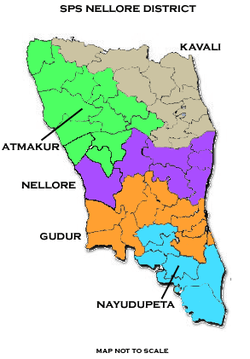
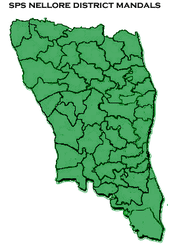
The district has six revenue divisions viz., Atmakur, Naidupet, Sullurpet, Nellore, Gudur and Kavali, each headed by a sub collector.[19][20] These revenue divisions are divided into 46 mandals in the district. These 46 mandals consists of 1177 villages, 10 towns. The 10 towns (or urban settlements) in the district include, 4 statutory and 5 census towns. The statutory towns constitute 1 municipal corporation and 5 municipalities. The only municipal corporation is Nellore and the 5 municipalities in the district are Atmakur, Gudur, Kavali, Sullurpeta, Kovur and Venkatagiri.[19] The 5 census towns are Buja Buja Nellore, L.A.Sagaram, Tada Khandrika, Vinnamala, Yerrabalem.[21]The towns in Nellore district are Kovur, Nellore district , Atmakur, Nellore district.
Mandals
The list of 46 mandals in Nellore district under 3 revenue divisions are listed in the following table:[19][20][21]
Culture
Art and literature
The most famous Dargah (holy tomb) in AP State Barashaheed dargah is located in Nellore. Every year some lakhs of people visit dargah and receive holy blessings there. The most widely followed culture and festival Rottela Panduga is celebrated in Nellore. It is truly followed that wishes which are to be fulfilled in one's life become 100% fulfilled. So the Rottela Panduga is followed by many people all over India. Nellore1 region produced famous Telugu artists ranging from ancient poets like Tikkana and to modern artists like Atreya. Ancient Telugu poets Tikkana, Molla, Marana, Ketana laid foundations for Telugu literature here. Tikkana, the second in Kavitrayam translated Sanskrit epic Mahabharat. Molla, the second Telugu poetess had translated Ramayan into Telugu. Ketana, a disciple of Tikkana, dedicated his work called "Dasakumara Charitram" to Tikkana. Ketana also wrote Andhrabashabushanam, a grammar book for Telugu. Marana, another poet and disciple of Tikkana wrote "Markandeya Puranam". Ramarajabhushanudu from this region was patronised by Krishnadevaraya. Poet Gunturu Seshendra Sarma is also from this region
The main entertainment in the region is movies and related activities. S. P. Balasubrahmanyam, one of the India's top singers, hailed from Nellore. Famous Telugu lyrics writer Acharya Atreya is from this region. Pattabi Rami Reddy, a poet and director from Nellore wrote Ragala Dozen (A Dozen Melodies), a collection that recorded his observations in Madras and Nellore. He also produced a Telugu film, Pellinaati Pramanalu, the national award winner, and directed films Samskara, Chandamarutha, Sringaramasa, and Devara Kaadu.[22] Nellore also is place of many yesteryear Telugu actors like Rajanala and Ramana Reddy and Telugu actress Vanisree, playback singers like S. P. Balasubramanyam, S. P. Sailaja, V. T. Venkataram, a famous consumer activist, hails from Nellore.
Notable personalities
Notable politicians include, Nedurumalli Janardhana Reddy, chief Minister of Andhra Pradesh from 1990 to 1992;Bezawada Gopala Reddy, chief Minister of Andhra state from 1954 to 1956; Puchalapalli Sundaraiah, founding member of the CPI (M), Alladi Krishnaswamy Iyer ;Smt.Panabaka Lakshmi , former Union Minister Muppavarapu Venkaiah Naidu-Vice President of India; film industry include, Singeetam Srinivasa Rao, S. P. Balasubrahmanyam, A. Kodandarami Reddy, S. Thaman, M. S. Reddy, A. M. Rathnam; Vanisree; Ponaka Kanakamma, social worker and activist; Gunturu Seshendra Sarma, a poet; Malli Mastan Babu- Indian Mountaineer.
Transport
The total of core road network of the district is 1,200.285 km (745.823 mi). It includes, 524.045 km (325.626 mi) of existing and a proposed length of 676.240 km (420.196 mi).[23] National Highway 16 paases through the city.
Krishnapatnam Port is one of the important port situated in the district on the coast of Bay of Bengal.[24] Another port, named as Dugarajapatnam Port is a proposed port in the district.[25]
Education
The primary and secondary school education is imparted by government, aided and private schools, under the School Education Department of the state.[26][27] As per the school information report for the academic year 2017–18, there are a total of 4,489 schools. They include, 21 government, 3,140 mandal and zilla parishads, 2 residential, 1077 private, 10 model, 10 Kasturba Gandhi Balika Vidyalaya (KGBV), 106 municipal and 123 other types of schools.[28] The total number of students enrolled in primary, upper primary and high schools of the district are 3,95,092.[29]
Temples
The following hundred temples under the management of Endowments Department[30].
| S.no | Temple | Mandal | Village |
| 1 | Sri Prasanna Venkateswara Swamy temple | Vidavalur | Alaganipadu |
| 2 | Sri Seetarama Swamy temple | Nellore | Allipuram |
| 3 | Sri Veeranjaneya Swamy Temple | Nellore | Allipuram |
| 4 | Sri Siddeswara Swamy etc., Temple | Allur | Allur |
| 5 | Sri Atmarama Swamy Temple | Sangam | Annareddipalem |
| 6 | Sri Kasivisweswara Swamy temple | Kondapuram | Audimurthipuram |
| 7 | Sri Prasanna Venkateswara Swamy temple | Bogole | Bitragunta |
| 8 | Sri Ramalingeswara Swamy temple | Jaladanki | Brahmanakraka |
| 9 | Sri Venugopala Swamy temple | Jaladanki | Brahmanakraka |
| 10 | Sri Annapoorna Sametha Kasi Visweswara Swamy Temple | Butchireddipalem | Buchireddypalem |
| 11 | Sri Gangaparvathi Sametha Janaki Ramalingeswara Swamy temple | Kavali | Budamgunta |
| 12 | Sri Chennakeswava Swamy Temple | Chejerla | Chejerla |
| 13 | Sri Chennakesava Swamy temple | Chillakur | Chinthavaram |
| 14 | Sri Venugopala Swamy temple | Chillakur | Chinthavaram |
| 15 | Sri Chennakesava Swamy Temple | Chejerla | Chittaluru |
| 16 | Sri Veerabhadreswara Swamy Temple | Chejerla | Chittaluru |
| 17 | Sri Mallikarjuna Swamy temple | Butchireddipalem | Damaramadugu |
| 18 | Sri Darmaraja swamy temple@ Muthayalpet | Gudur | East Gudur (R) |
| 19 | Sri Kodandarama Ramanjaneya Swamy Temple @ Konetimitta | Gudur | East Gudur (R) |
| 20 | Sri Moolastaneswara Swamy temple | Gudur | East Gudur (R) |
| 21 | Sri Prasanna Venkateswara Swamy Temple @ Raja Street | Gudur | East Gudur (R) |
| 22 | Sri Chennakesava Swamy temple | Gudur | East Gudur (R) |
| 23 | Sri Udayakaleswara Swamy temple | Kodavalur | Gandavaram |
| 24 | Sri Prasanna Venkateswara Swamy temple | Allur | Gogulapalle |
| 25 | Sri Bheemeswara Swamy temple | Kota | Gudali |
| 26 | Sri Ramalingeswara Swamy Temple | Kondapuram | Gudavalluru (Kondapuram) |
| 27 | Sri Valmika Nadha Swamy temple | Chittamur | Gunupadu |
| 28 | Sri Venugopala Swamy temple | Chittamur | Gunupadu |
| 29 | Sri Chennakesava Swamy temple | Kovur | Inamadugu |
| 30 | Sri Veerabhadra Swamy temple | Indukurpet | Indukurpet Bit - I |
| 31 | Sri Kodandarama Swamy Temple @ Nellimitta | Indukurpet | Indukurpet Bit - Ii |
| 32 | Sri Prasanna Venkateswara Swamy temple | Allur | Indupuru |
| 33 | Sri Mallikarjuna Swamy Kamakshi tayee Ammavari temple | Butchireddipalem | Jonnawada |
| 34 | Sri Chennakesava Swamy temple | Kaluvoya | Kaluvoya |
| 35 | Sri Kamakshi Sametha Ramalingeswara Swamy Temple | Gudur | Kandali |
| 36 | Sri Nageswara Swamy temple | Kodavalur | Kodavalur |
| 37 | Sri Sreedhara Swamy temple | Kodavalur | Kodavalur |
| 38 | Sri Kumbeswara Swamy temple | Indukurpet | Komarika |
| 39 | Sri Chennakesava Swamy temple | Sydapuram | Kommipadu |
| 40 | Sri Anjaneya Swamy Temple | Thotapalligudur | Kothapalem |
| 41 | Sri Koteswara Swamy temple | Chejerla | Kotitheertham |
| 42 | Sri Venugopala Swamy temple | Atmakur | Mahimalur |
| 43 | Sri Subramanyeswara Swamy temple | Chittamur | Mallam |
| 44 | Sri Nageswara Swamy temple | Butchireddipalem | Minagallu |
| 45 | Sri Nageswara Swamy temple | Kovur | Modegunta |
| 46 | Sri Prasanna Visweswra Swamy temple | Indukurpet | Mypadu |
| 47 | Sri Kodanda Rama Swamy temple | Indukurpet | Mypadu |
| 48 | Sri Kondandarama Swamy Temple | Kaluvoya | Nagulavellaturu |
| 49 | Sri Janardhana Swamy temple | Duttalur | Narrawada |
| 50 | Sri Jalasiddeswara Swamy temple | Vakadu | Nellipudi |
| 51 | Sri Moolastaneswara Swamy temple | Nellore | Nellore-Ii (U) |
| 52 | Sri Anjanaya Swamy temple @ Rayagi street | Nellore | Nellore-Ii (U) |
| 53 | Sri Anjanaya Swamy temple@ Santhapet | Nellore | Nellore-Ii (U) |
| 54 | Sri Irukalalaparameswari Ammavari Temple | Nellore | Nellore-Ii (U) |
| 55 | Sri Kodanda Rama & Kasivisweswara Swamy temples@ Usmansahebpet | Nellore | Nellore-Ii (U) |
| 56 | Sri Malleswara swamy temple@Nawabpet | Nellore | Nellore-Ii (U) |
| 57 | Sri Talpagiri Ranganadha Swamy temple | Nellore | Nellore-Ii (U) |
| 58 | Sri Uma Maheswara Swamy Temple @ CAM High School Road, Mulapet | Nellore | Nellore-Ii (U) |
| 59 | Sri Alaganadha & Anjanaya Swamy temple | Indukurpet | Nidumusali |
| 60 | Sri Varadha Raja Swamy temple | Allur | North Mopuru |
| 61 | Sri Rameswara and Venugopala Swamy Temple | Indukurpet | Pallipadu |
| 62 | Sri Pandurangeswara Swamy Temple | Vakadu | Pantrangam |
| 63 | Sri Alaganadha Swamy temple | Vidavalur | Parlapalle |
| 64 | Sri kailasanadha Swamy temple | Vidavalur | Parlapalle |
| 65 | Sri Anatha Padmanabha Swamy temple | Vidavalur | Parlapalle |
| 66 | Sri Vinayaka Swamy temple | Vidavalur | Parlapalle |
| 67 | Sri Chandra Mouleswara Swamy temple | Nellore | Pedda Cherukur |
| 68 | Sri Rama Mandiram | Nellore | Pedda Cherukur |
| 69 | Sri Amrutheswara and Venugopalaswamy Temples | Thotapalligudur | Peduru |
| 70 | Sri Chennakesava Swamy temple | Pellakur | Pellakur |
| 71 | Sri Radha Madhava Swamy Temple | Kaluvoya | Pennabaddavolu |
| 72 | Sri Nageswara Swamy Temple | Butchireddipalem | Penuballe |
| 73 | Sri Kalahasteeswara Swamy temple | Manubolu | Pidurupalem |
| 74 | Sri Poleramma Temple | Podlakur | Podalakur |
| 75 | Sri Chendra Mouleswara Swamy Temple | Thotapalligudur | Potlapudi |
| 76 | Sri Kodanda Rama Swamy temple | Nellore | Pottepalem |
| 77 | Sri Kalahstheswara Swamy Temple | Kota | Putchalapalle |
| 78 | Sri Ramalingeswara Swamy Temple | Vidavalur | Ramaterdham |
| 79 | Sri Ramalingeswara Swamy Temples | Kavali | Rudrakota |
| 80 | Sri Sangameswara Swamy temple | Sangam | Sangam |
| 81 | Sri Siddeswara Swamy Temple | Kaligiri | Siddana Konduru |
| 82 | Sri Kodanda Rama Swamy temple | Allur | Singapeta |
| 83 | Sri Subramanyeswara Swamy temple | Balayapalle | Subrahmanyam |
| 84 | Sri Bheemeswara Swamy Vari Temple | Venkatachalam | Survepalle Bit - I |
| 85 | Sri Kodanda Rama Swamy temple | Chillakur | Thamminapatnam |
| 86 | Sri Gurunadha Swamy Temple | Vidavalur | Thummagunta |
| 87 | Sri Chennakesava Swamy temple | Kavali | Thummalapenta |
| 88 | Sri Someswara Swamy Temple | Sydapuram | Thummalathalupur |
| 89 | Sri Muthyalamma Ammavari Temple | Chillakur | Turpu Kanupur |
| 90 | Sri kasi Visweswara Swamy Temple | Dagadarthi | Uchaguntapalem |
| 91 | Sri Sagareswara Swamy temple | Vidavalur | Utukuru |
| 92 | Sri Bheemeswara Swamy temple | Sangam | Vangallu |
| 93 | Sri Janardhana Swamy temple | Thotapalligudur | Varigonda |
| 94 | Sri Alaganadha Swamy temple | Vidavalur | Vavilla |
| 95 | Sri Chennakesava Swamy temple | Butchireddipalem | Vavveru |
| 96 | Sri Tripuranthaka Swamy temple | Butchireddipalem | Vavveru |
| 97 | Sri Kasivisweswara Swamy temple | Dagadarthi | Velupodu |
| 98 | Sri Ramalingeswara Swamy temple | Vidavalur | Vidavalur |
| 99 | Sri Alaganadha Swamy temple | Gudur | West Gudur (R) |
| 100 | Sri Nagareswara Swamy temple @ Patimitta H/o | Chittamur | Yakasiri |
References
- ↑ "District – Guntur". Andhra Pradesh Online Portal. Archived from the original on 8 June 2015. Retrieved 29 August 2014.
- 1 2 "Nellore district profile". Andhra Pradesh State Portal. Archived from the original on 15 July 2014.
- ↑ Staff, Government Of Madras; Madras, Government of (1 January 1942). Gazetteer of the Nellore District: Brought Up to 1938. Asian Educational Services. ISBN 9788120618510.
- ↑ "The martyr of Telugu statehood". The Hindu. Chennai, India. 11 November 2002.
- ↑ Nellore became revenue unit. Telugupeople.com. Retrieved on 13 June 2012.
- ↑ Law, Gwillim (25 September 2011). "Districts of India". Statoids. Retrieved 11 October 2011.
- ↑
- ↑
- ↑ Srivastava, Dayawanti et al. (ed.) (2010). "States and Union Territories: Andhra Pradesh: Government". India 2010: A Reference Annual (54th ed.). New Delhi, India: Additional Director General, Publications Division, Ministry of Information and Broadcasting (India), Government of India. pp. 1111–1112. ISBN 978-81-230-1617-7.
- ↑ "Island Directory Tables: Islands by Land Area". United Nations Environment Program. 18 February 1998. Retrieved 11 October 2011.
Negros 13,074km2
- ↑ NELLORE WASTELANDS INFORMATION -AREA IN Sq.Mts (sic). rd.ap.gov.in
- 1 2 3 4 5 6 "District Census 2011". Census2011.co.in. 2011. Retrieved 30 September 2011.
- ↑ US Directorate of Intelligence. "Country Comparison:Population". Retrieved 1 October 2011.
Armenia 2,967,975 July 2011 est.
- ↑ "2010 Resident Population Data". U. S. Census Bureau. Retrieved 30 September 2011.
Mississippi 2,967,297
- ↑ Indian Census data.2011 Archived 27 July 2007 at WebCite. Censusindiamaps.net. Retrieved on 13 June 2012.
- 1 2 "Economy of Nellore District". Andhra Pradesh Economic Development Board. Retrieved 25 April 2017.
- ↑ Records, The Daily (2018-02-15). "Top 10 Largest Mica Producing States in India". The Daily Records. Retrieved 2018-03-21.
- ↑ "Indian Minerals Yearbook 2013 (Part- III : Mineral Reviews)" (PDF). http://ibm.gov.in. Retrieved 2018-03-21. External link in
|website=(help) - 1 2 3 "Geographic Information". Nellore District Official Website. Archived from the original on 31 January 2015. Retrieved 22 October 2014.
- 1 2 "Ten new revenue divisions created". The Hindu. Hyderabad. 4 April 2013. Retrieved 31 October 2014.
- 1 2 "District Census Handbook – Sri Potti Sriramulu Nellore" (PDF). Census of India. p. 26,56. Retrieved 18 January 2015.
- ↑ Fruits of labour. Hindu.com (18 February 2005). Retrieved on 2012-06-13.
- ↑ ":: APRDC ::". Andhra Pradesh Road Development Corporation. Roads and Buildings Department. Retrieved 9 November 2016.
- ↑ "Krishnapatnam Port Company Ltd". krishnapatnam.com.
- ↑ "Decks cleared for Dugarajapatnam port". The Times of India.
- ↑ "School Education Department" (PDF). School Education Department, Government of Andhra Pradesh. Archived from the original (PDF) on 27 December 2015. Retrieved 7 November 2016.
- ↑ "The Department of School Education – Official AP State Government Portal". www.ap.gov.in. Archived from the original on 7 November 2016. Retrieved 7 November 2016.
- ↑ "School Information Report". Commissionerate of School Education. Government of Andhra Pradesh. Retrieved 8 November 2016.
- ↑ "Student Information Report". Commissionerate of School Education. Child info 2015–16, District School Education – Andhra Pradesh. Retrieved 8 November 2016.
- ↑ "Trust Boards Abstract". AP Temples Portal, Government of Andhra Pradesh. Retrieved 24 July 2018.
Further reading
- History of Andhras up to 1565, Durga Prasad, P. G. Publishers, Guntur.
- Samagra Andhrula Charitram
External links
| Wikimedia Commons has media related to Nellore district. |